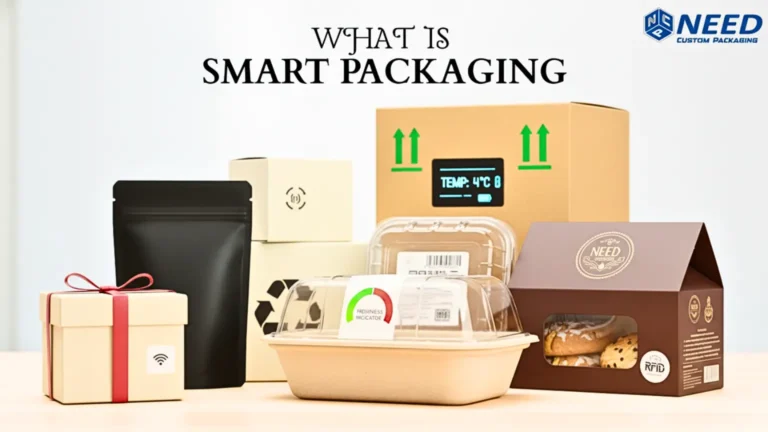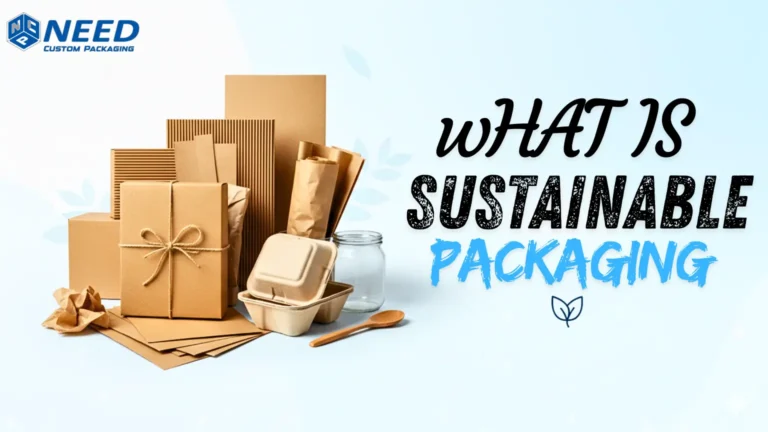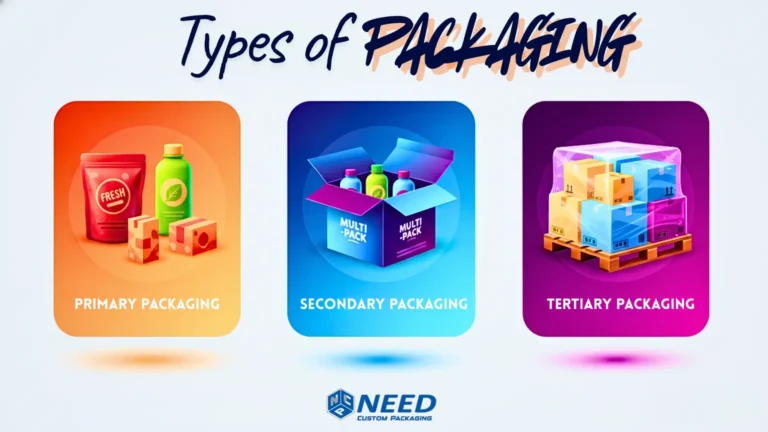Do you know what sustainable packaging is and why every brand is talking about it? Sustainable packaging is designed to protect products while minimizing harm to the planet.
This includes materials such as recycled boxes and compostable wraps, which help businesses reduce waste and appeal to environmentally conscious customers.
As the world shifts towards greener solutions, adopting sustainable packaging is not just an ethical choice; it’s also a smart and strategic move essential for long-term success.
Let’s explore “what is sustainable packaging”, why it’s necessary, and how it’s transforming modern business.
What Is Sustainable Packaging?
Sustainable packaging involves using materials and designs that benefit the environment throughout the entire lifecycle, from production to disposal.
The purpose is to create packaging that uses less stuff, produces less trash, and fits into a system where resources are reused and recycled.
It’s not just about creating recyclable items; it’s about being mindful of our planet. Sustainable packaging examines the origin of materials, their production process, transportation, and eventual fate after use.
For example, companies like Unilever and Nestlé have committed to ensuring that all their packaging will either be reused, recycled, or composted.
As a result, this change indicates that caring about our environment through packaging is becoming an essential standard for businesses, not just a passing trend.
Traditional Packaging vs Sustainable Packaging
Traditional packaging typically utilizes materials such as plastic and Styrofoam, which are derived from fossil fuels.
These types of materials will take hundreds of years to break down, releasing harmful substances into our soil and water.
On the other hand, sustainable packaging focuses on using materials that are either renewable or made from recycled products.
These designs are often easier to reuse or compost. For instance, replacing plastic mailers with alternatives made from recycled cardboard or paper can significantly reduce waste.
The key difference lies not only in the materials used, but also in how we approach packaging.
Want to know more about sustainability? Begin with our comprehensive guide to “What is Packaging.” It will give you an easy-to-understand overview of the basics.
Main Types of Sustainable Packaging
Sustainable packaging comes in different varieties, each with its own advantages. By choosing these eco-friendly alternatives, both businesses and consumers will play an essential role in minimizing waste and safeguarding our planet for future generations.
Let’s take a closer look at some of the most popular types.
Recycled Packaging:
Recycled packaging is made from materials that have already been used and processed, like old cardboard, paper, or plastic.
This helps keep waste out of landfills and reduces the need to use new resources. For example, Coca-Cola has developed bottles made entirely from recycled plastic, which has helped lessen its impact on the environment.
Reusable Packaging:
Reusable packaging is designed to be used multiple times. This includes items like glass jars, refillable containers, and sturdy boxes.
Many beauty companies now provide refill stations where customers can bring back their original bottles, saving both money and reducing waste.
Compostable Packaging:
Compostable packaging is created from natural materials such as cornstarch, sugarcane, or bamboo. Under the right conditions, it breaks down into a rich compost that will benefit the soil.
Companies that sell organic food, like Nature’s Path, often choose compostable packaging to reflect their commitment to caring for the environment.
Biodegradable Packaging:
Biodegradable packaging decomposes naturally through the action of microorganisms, turning into water, carbon dioxide, and organic materials.
It serves as a better option than traditional plastic for applications such as mailers, utensils, and single-use wraps. The main difference between compostable and biodegradable packaging is how quickly and in what conditions they break down.
Key Reasons Why Sustainable Packaging Matters?
Adopting sustainable packaging is not simply an ethical choice. It’s a pivotal business strategy that aligns with today’s consumer values.
Transitioning to eco-friendly packaging enables companies to meet growing consumer demands, achieve significant cost savings, and improve their overall market reputation.
Below are several compelling reasons why businesses should prioritize sustainable packaging solutions.
Reason#1: Reduces Waste & Pollution
Utilizing sustainable materials plays a crucial role in mitigating environmental issues by significantly decreasing the volume of non-recyclable waste that ends up in landfills.
By implementing efficient recycling and composting systems, businesses will not only lower their environmental footprint but also contribute to a circular economy.
This reduction in waste and pollution helps protect ecosystems and will lead to improved community relations.
Reason#2: Builds Customer Trust
Today’s consumers are increasingly conscientious about their purchasing choices, with a growing preference for brands that demonstrate a commitment to sustainability.
Companies that adopt eco-friendly packaging will grow credibility and promote customer loyalty. In fact, research indicates that 74% of buyers are willing to pay a premium for products that employ sustainable packaging.
This trend highlights the potential for businesses to differentiate themselves in a competitive marketplace while driving customer loyalty.
Reason#3: Meets Regulations
In response to the global environmental crisis, governments around the world are instituting more stringent packaging waste legislation.
By opting for eco-packaging solutions, businesses will ensure compliance with these evolving regulations, thus avoiding potential financial penalties and reputational damage.
For example, the European Union’s Packaging and Packaging Waste Regulation (PPWR) mandates that by 2030, all packaging must be recyclable or reusable. Proactively adopting sustainable practices positions companies as forward-thinking leaders within their industries.
Reason#4: Saves Money Long Term
While the initial investment in sustainable packaging solutions may seem complicated, the long-term financial benefits will be substantial.
Sustainable packaging typically leads to reduced material usage, enhanced energy efficiency, and optimized logistics processes.
For instance, lightweight packaging will result in lower shipping costs, as it reduces the overall weight and volume transported.
Additionally, operational efficiencies will translate to lower waste disposal costs and increased margins.
Reason#5: Lowers Carbon Footprint
By utilizing renewable resources and refining production methods, brands will significantly reduce their carbon emissions through sustainable packaging initiatives.
Many organizations are now actively tracking and reporting their carbon footprint as part of their environmental commitment.
Transparency in these efforts not only reflects a company’s dedication to sustainability but also resonates with eco-conscious consumers who prioritize brands that take actionable steps to improve their environmental impact.
Popular Eco-Friendly Packaging Materials
As more people become aware of environmental issues, many companies are finding new ways to package their products in a greener way. These sustainable packaging options are helping businesses become more eco-friendly while still meeting customer needs.
Here are some popular materials being used:
- Cardboard: Cardboard is a favorite for many businesses. It breaks down naturally over time, is strong, and can be easily recycled. This makes it an excellent option for online shopping and food deliveries.
- Recycled Paper: This type of paper is made from old paper products, which helps save trees and energy. It’s often used for wrapping items, making labels, and creating inserts for packaging.
- Plant-Based Bioplastics: These are special plastics made from natural materials like sugarcane, corn, or algae. They are lighter, more rigid, and will break down in compost, offering a healthier choice than traditional plastic.
- Glassine: This is a smooth and see-through paper that’s commonly used for items like baked goods and beauty products. It is grease-resistant, biodegradable, and will be easily recycled in regular curbside bins.
- Kraft Paper: Known for its durability and natural appearance, Kraft paper is often used for bags, wrapping, and boxes, giving products a nice, earthy look.
- Mushroom: This unique material, derived from mushroom roots, will completely break down in compost. It’s a great alternative to Styrofoam, used for packaging items like electronics and furniture.
- Seaweed Packaging: Made from seaweed, this type of packaging is not only biodegradable but also edible! It’s being used for single-use items like small packets and cups.
- Cornstarch: This material, which looks like plastic but is actually made from corn, breaks down easily and is ideal for takeout containers, utensils, and trays.
How Businesses Can Effectively Execute Sustainable Packaging Solutions
Transitioning to sustainable packaging is a complex process that requires careful planning and execution.
Here’s a comprehensive step-by-step process for companies aiming to adopt sustainable practices in their packaging operations.
Step 1: Review Your Current Packaging
Begin by conducting a detailed analysis of your existing packaging materials, production processes, and waste management systems.
Look for specific types of materials used (such as plastics, cardboard, or bubble wrap), assess the environmental impact of each, and calculate the volume of waste generated.
Identify key areas where improvements can yield significant sustainability benefits, such as reducing the carbon footprint or enhancing recyclability.
Step 2: Set Clear Sustainability Goals
Set specific, measurable, achievable, relevant, and time-bound (SMART) objectives to guide your transition.
For example, aim to reduce plastic use by 50% within the next five years or commit to ensuring that all packaging materials are 100% recyclable and sourced from renewable materials by the year 2030.
Such clear targets will help in tracking progress and maintaining accountability within the organization.
Step 3: Reduce and Right-Size Materials
Consider your packaging design to identify and eliminate unnecessary layers or components that contribute to waste. Employ techniques such as “right-sizing,” where you select packaging solutions that closely fit the product dimensions, reducing excess material without compromising protection. This approach not only minimizes waste but also lowers shipping costs due to reduced weight and volume.
Step 4: Focus on High-Impact Areas
Prioritize efforts on packaging components that have the highest negative environmental impact.
This may include items such as single-use plastics or complex laminates that are difficult to recycle.
By targeting these areas first, businesses will maximize resource efficiency and make a substantial difference in their overall sustainability profile.
Step 5: Test Eco-Friendly Materials
Before fully integrating new sustainable materials into your supply chain, pilot test them to evaluate their performance.
Ensure that these materials maintain the required quality, durability, and aesthetics to meet consumer expectations.
Gather feedback from customers and stakeholders to refine your packaging choices, enhance user experience, and align with sustainability goals.
Step 6: Partner with Sustainable Suppliers
Collaborate with suppliers and manufacturers that specialize in eco-friendly packaging solutions.
Seek partners who prioritize sustainable practices in their operations, from sourcing renewable materials to implementing efficient production methods.
If you’re interested in eco-conscious and creative packaging options, consider reaching out to Need Custom Packaging; they offer sustainable, high-quality designs tailored to your brand.
Establishing strong partnerships like this will help you scale sustainable packaging throughout your entire product line while supporting your environmental goals.
End Result:
Sustainable packaging is not only about protecting the planet; it’s also about building better businesses for the future.
As more people become aware of environmental issues, companies that prioritize eco-friendly practices will stand out.
By opting for sustainable packaging, you demonstrate a commitment to the environment while also creating a brand that values responsibility, creativity, and trust.
The future of packaging is eco-friendly. Will your business join this movement?
Start exploring sustainable packaging options with Need Custom Packaging Suppliers and become part of the global effort towards a cleaner, brighter, and more sustainable future.






